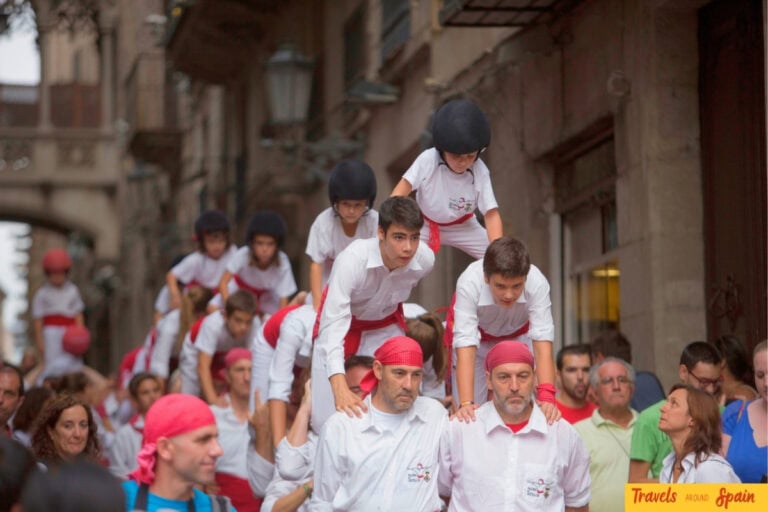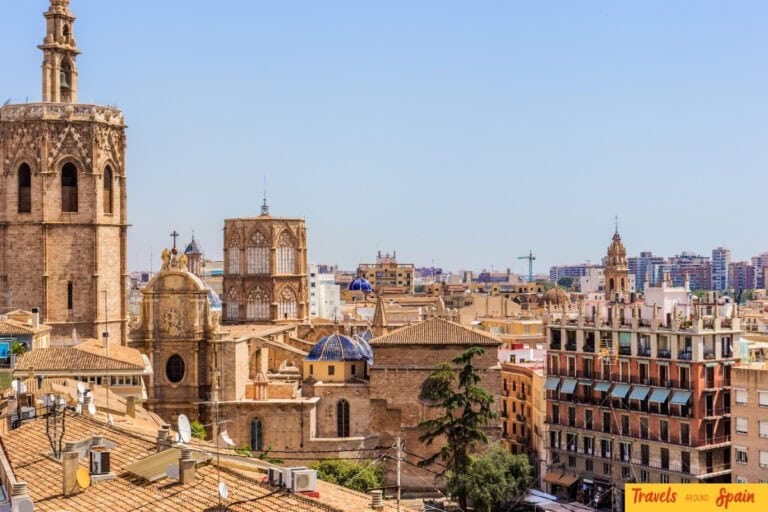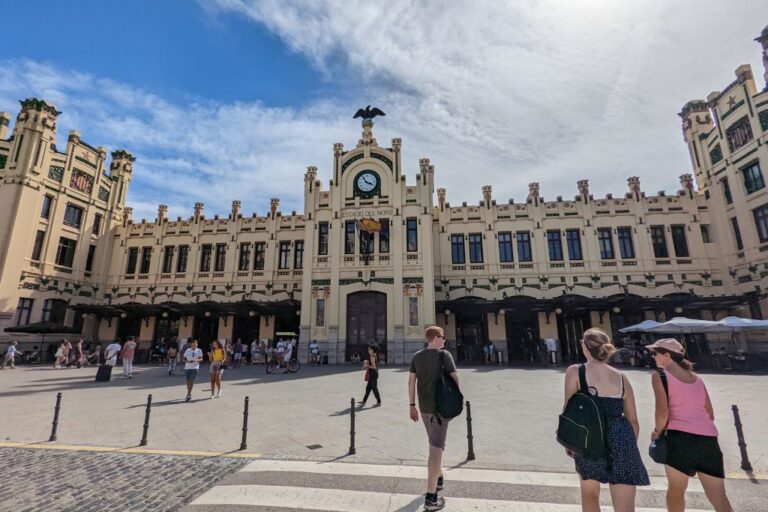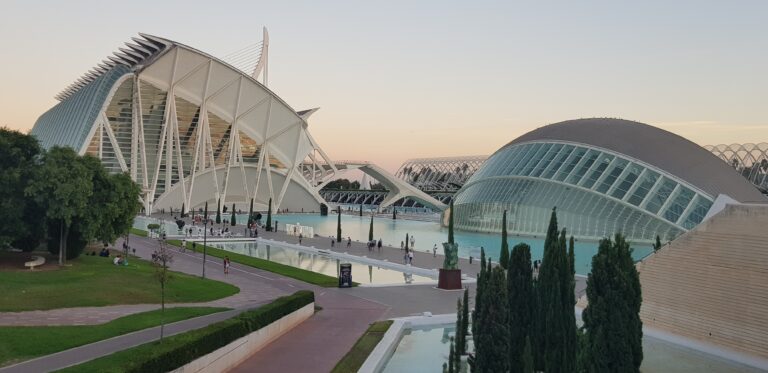Best Things to Do in Valencia: Top 15 Experiences & Attractions
From stunning architecture to vibrant beaches – Valencia has everything
By Liam Mulligan | Published on April 2, 2024 |Modified on August 30, 2025
Valencia is one of Spain’s greatest cities – a stunning Mediterranean coastal gem that’s criminally underrated. This vibrant Valencia Spain destination regularly features amongst the best places to visit in Spain and topped my list of the 20 Best Places To Visit In Spain For First-Timers. Yet Valencia remains relatively unknown compared to Madrid and Barcelona, making it the perfect escape from Spain’s crowded tourist hotspots.
I fell in love with Valencia during my first visit and returned with my family in September 2022 for a week – they all fell head-over-heels for the city too! Valencia has tonnes of incredible things to do for every type of traveller: world-class museums, pristine Mediterranean beaches, authentic paella restaurants, vibrant street art districts, and buzzing nightlife. With over 300 days of sunshine yearly, you could easily spend a month here discovering new attractions.
Whether you’re planning a weekend break or extended Spanish holiday, this complete Valencia travel guide covers the 15 best things to do in Valencia in 2025 – from iconic must-see attractions like the City of Arts and Sciences to local hidden gems that most tourists completely miss.
Valencia at a Glance
Short on time? Here’s your instant guide to the best things to do in Valencia.
- Best time to visit: March-May, September-November
- Top attraction: City of Arts and Sciences
- Must-try food: Authentic paella at Restaurant Navarro
- Best beach: Malvarrosa (30 minutes from centre)
- Getting around: Metro, buses, or walking in Old Town
- Best viewpoint: Miguelete Tower (€2 entry)
- Language: Spanish and Valencian (English widely spoken)
Historic Valencia & Cultural Attractions
1. Climb Miguelete Tower for Best Valencia Views
The Miguelete Tower is Valencia’s best viewpoint and the bell tower of the city’s majestic cathedral. Completed in 1429, the tower is 207 feet tall and coincidentally has 207 steps to the top.
Climbing the 207 steps rewards visitors with spectacular panoramic views stretching to the City of Arts and Sciences and Mediterranean Sea. It’s genuinely one of the best things to do in Valencia for first-time visitors wanting to get oriented.
Tickets cost just €2 for adults and €1 for children – making it Valencia’s best-value attraction. Open daily 10 AM-7:30 PM, though early morning or late afternoon offer the best lighting.
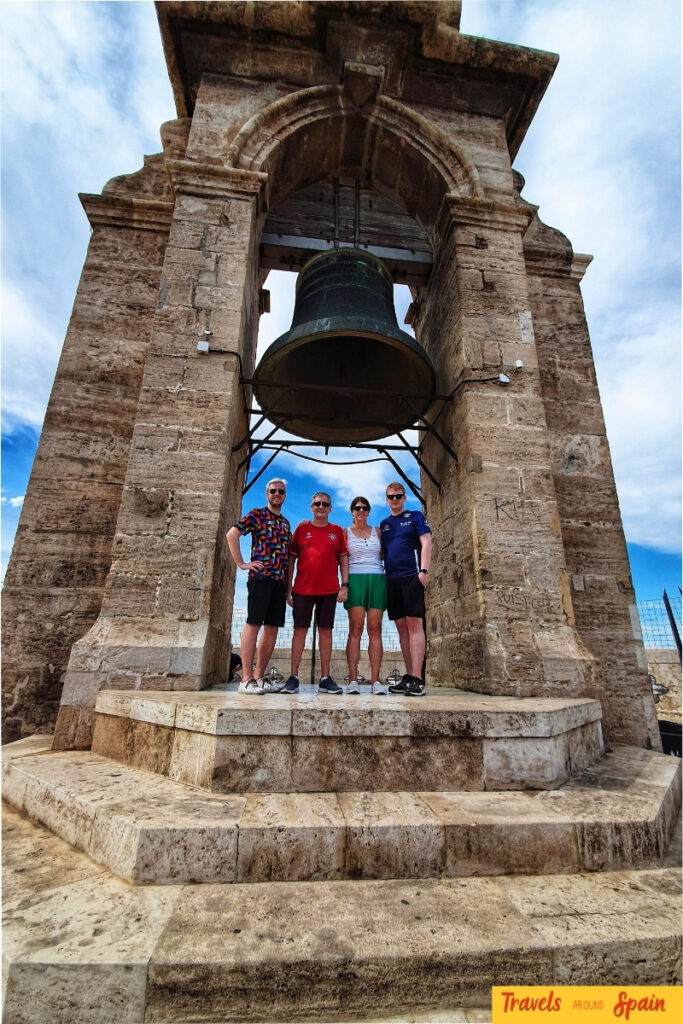
2. See the Holy Grail at Valencia Cathedral – Christianity’s Most Sacred Relic
One of Valencia’s most prized artefacts, the Holy Grail used in the Last Supper resides in Valencia Cathedral. Yes, you read that right – what many believe to be the actual chalice used in the Last Supper!
Whilst not historically proven, it has a compelling claim to being authentic – archaeologists dated it to the 2nd-1st Century BC with origins between Egypt and Palestine. You can visit the Holy Grail in a chapel on the cathedral’s right-hand side.
The cathedral costs €9 for adults with an excellent audio tour. Plan 60-90 minutes, dress modestly, and visit early morning to avoid crowds.
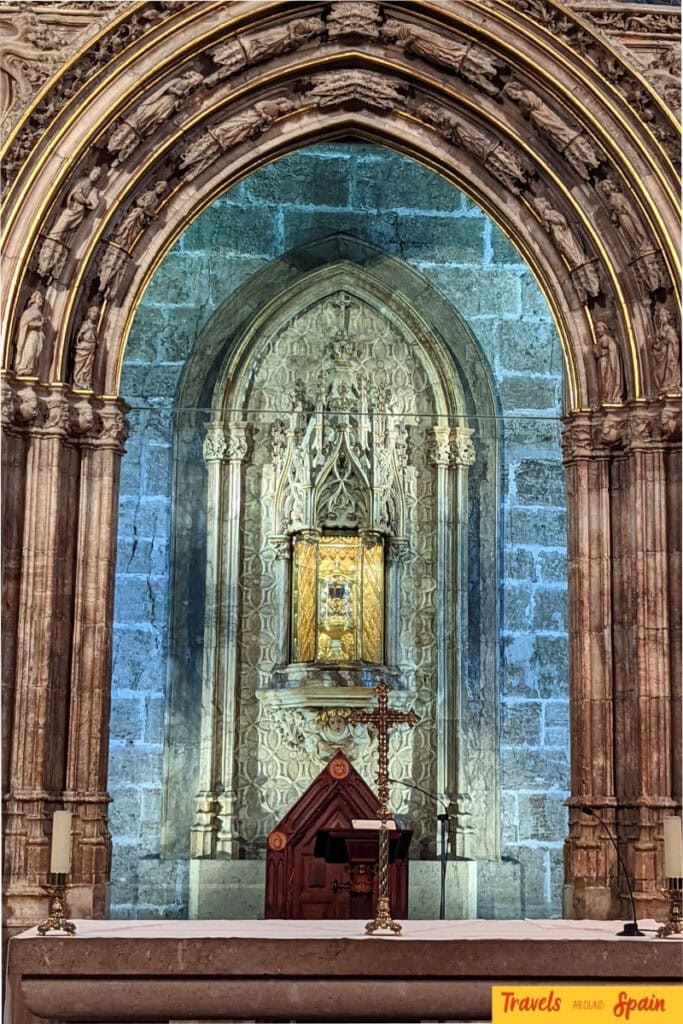
3. Explore Valencia’s Historic Old Town – Medieval Streets & Hidden Squares
Valencia’s Old Town (Ciudad Vieja/Ciutat Vella) is absolutely stunning and home to many of the best things to do in Valencia. We kept returning day after day during our visit – it’s that captivating!
This historic quarter is an enchanting labyrinth of narrow streets, hidden squares, and mediaeval buildings. First settled in Roman times, the Moorish and Gothic periods have both left their distinctive marks on the neighbourhood, making it one of Spain’s best-preserved historic centres.
Despite its historical importance, the Old Town isn’t a static museum. It buzzes with vibrant markets, lively squares, authentic tapas bars, and restaurants, serving as Valencia’s beating heart. During festivals like Las Fallas, the area truly comes alive with street parties and celebrations.
Many of Valencia’s top attractions are located here – Valencia Cathedral, the UNESCO-listed Silk Exchange, Central Market, and Serranos Towers. You’ll find yourself returning repeatedly, which is brilliant considering how beautiful it is.
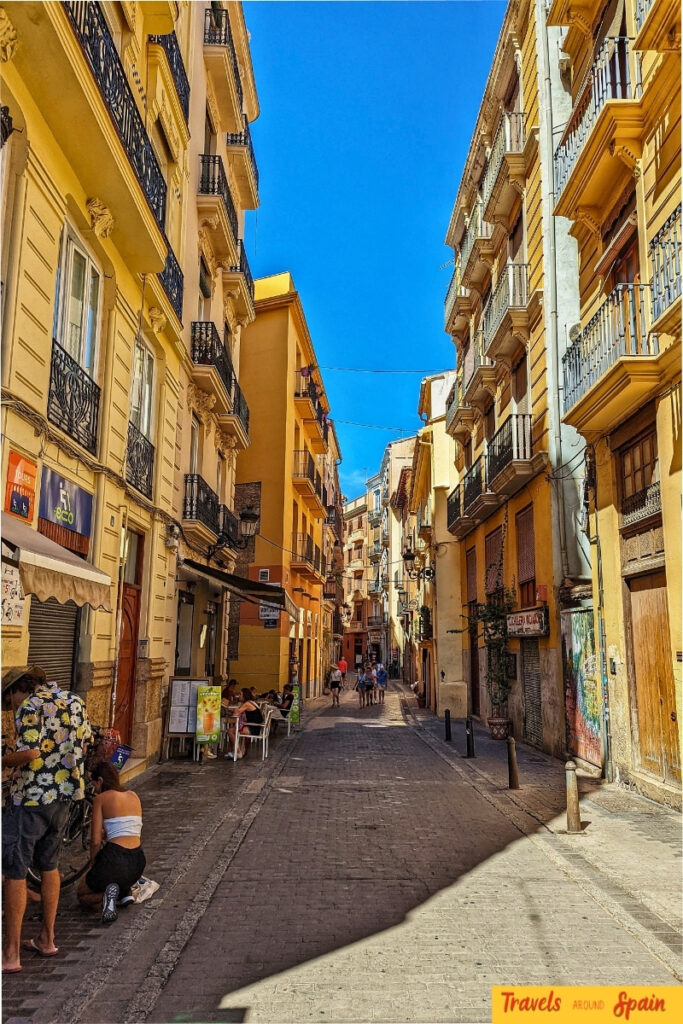
4. Silk Exchange – UNESCO World Heritage Architecture
Valencia’s Silk Exchange showcases the city’s wealthy merchant past and stands as one of Spain’s finest examples of civil Gothic architecture. This UNESCO World Heritage Site was constructed between the 15th and 16th centuries as a trading centre for silk merchants.
The building blends Gothic, Renaissance, and Baroque architectural styles and ranks amongst Valencia’s most significant landmarks. Being situated on the Mediterranean coast, Valencia became one of Europe’s most important port cities during this period.
The main Contract Hall is absolutely spectacular – adorned with intricate stone carvings, soaring vaulted ceilings, and ornate columns that showcase Valencia’s immense wealth during the silk trading era.
A visit to this UNESCO Heritage site transports you back to Valencia’s golden age of commerce and makes for a fascinating cultural stop in the city centre.
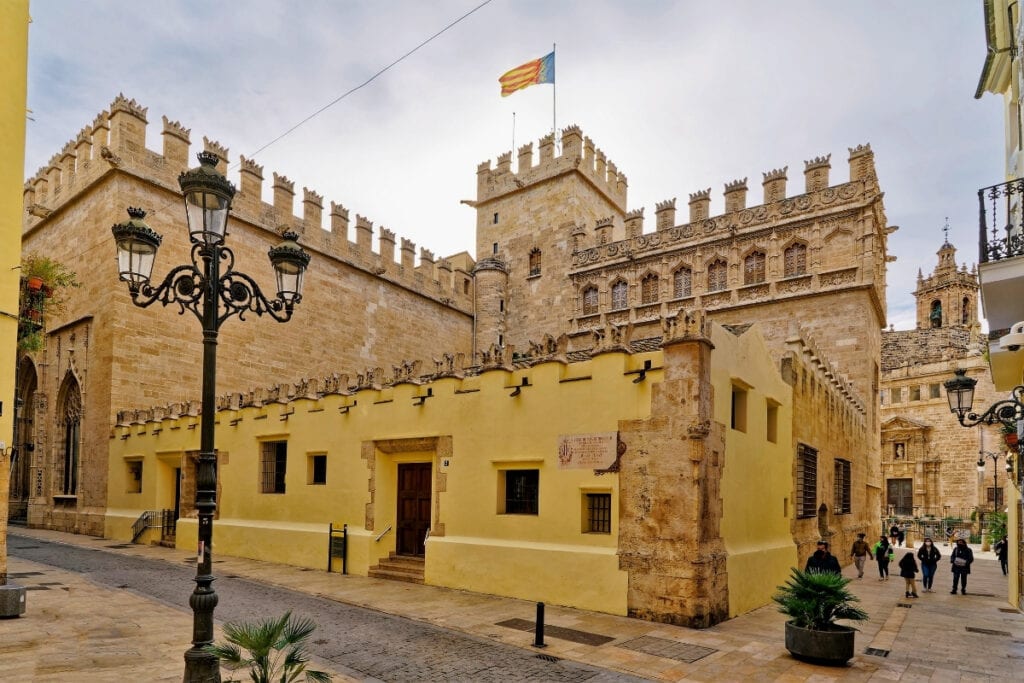
5. Plaza de la Virgen – The City’s Most Beautiful Square
Plaza de la Virgen is arguably Valencia’s most iconic square and serves as a focal point for both tourists and locals. Located in the heart of the Old Town, it’s the perfect spot to relax with a coffee and people-watch.
The centrepiece is the stunning Fountain of Turia – this Baroque masterpiece from the 18th century celebrates the Turia River and its tributaries, featuring a statue of Neptune, the Roman god of the sea.
The square hosts some of Valencia’s most important buildings:
- Valencia Cathedral (housing the Holy Grail)
- Basilica of the Virgin of the Helpless (patron saint of Valencia)
- Palace of the Generalitat (seat of Valencian government)
Given its historical importance and central location, Plaza de la Virgen offers the perfect introduction to Valencian life in this most historic setting.
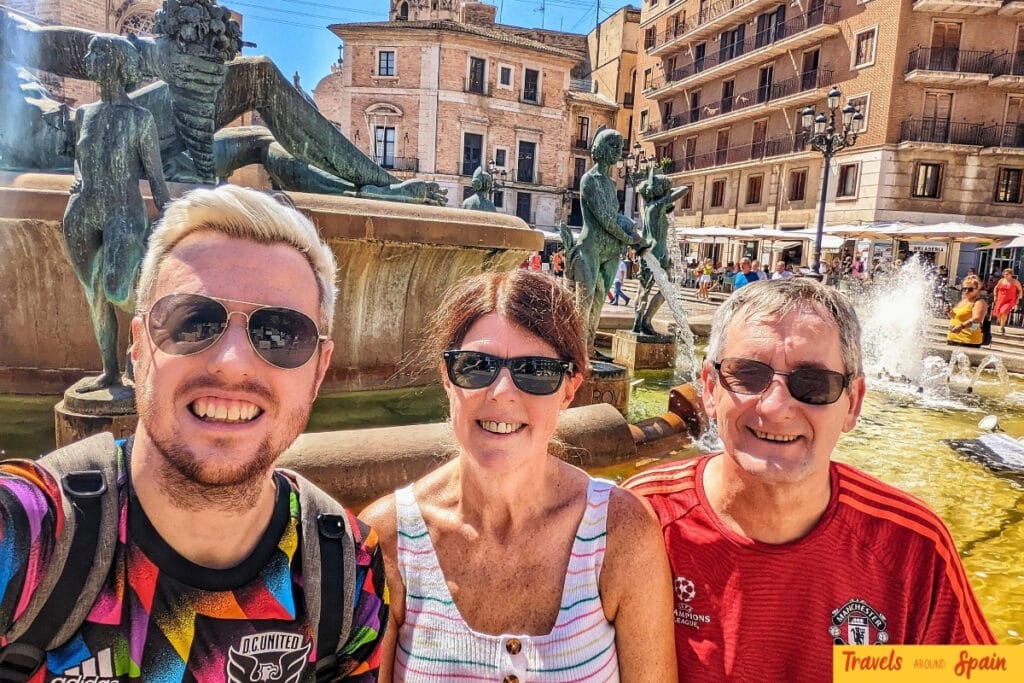
Modern Valencia Attractions
6. City of Arts and Sciences – Iconic Modern Complex
Possibly Valencia’s most famous attraction, the City of Arts and Sciences is a striking complex of modern architecture that needs to be seen to be believed. This futuristic collection of buildings next to the former Turia riverbed helped put Valencia on the international tourist map.
Voted one of Spain’s 12 Treasures, construction began on the complex in 1996. The final phase was finished in 2009 and it’s now one of the top things to do in Valencia for visitors of all ages.
Within the complex you’ll find Europe’s largest oceanographic aquarium, an opera house, an IMAX cinema, an interactive science museum, a planetarium, a laserium and a multipurpose events space. There are also multiple gardens and places to relax whilst marveling at the futuristic buildings.
You could easily spend a full day at the complex exploring the different attractions. With so much variety, there genuinely is something for everyone.
Pro-Tip: Book tickets in advance to avoid disappointment. Consider a combo ticket if visiting multiple attractions for better value. Valencia Tourist Card holders get 10% off admission prices.
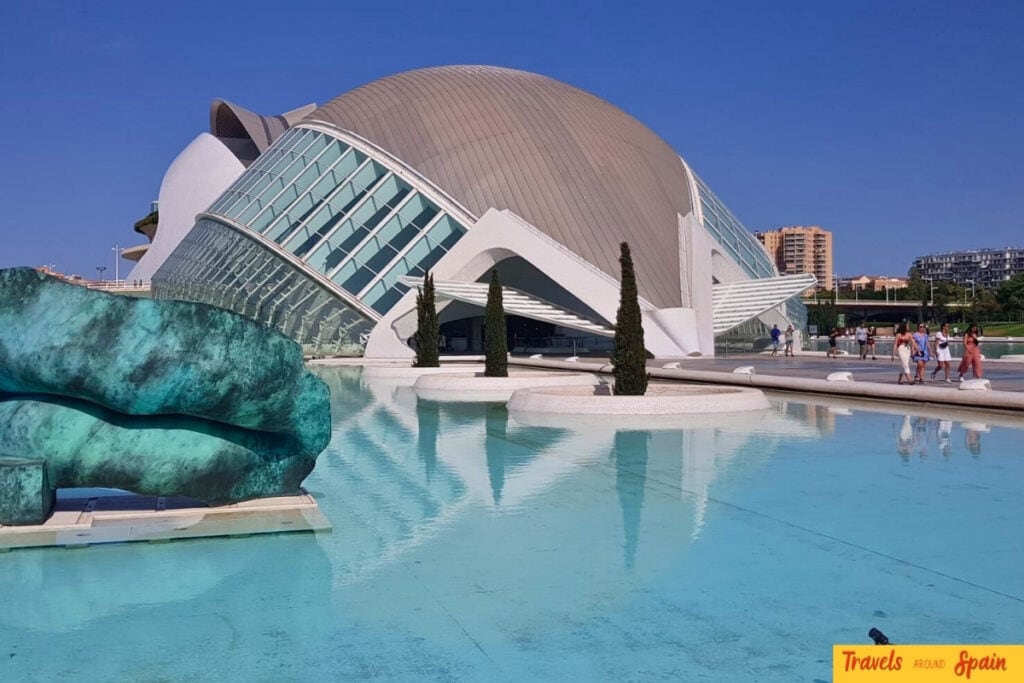
7. Oceanogràfic – Europe’s Largest Aquarium
The Oceanogràfic is Europe’s largest aquarium and located within Valencia’s City of Arts and Sciences complex. Opened in 2003, it’s one of Valencia’s most popular family attractions and a must-visit for anyone travelling with children.
The building is designed to resemble a water lily and splits into different sections, each representing a unique aquatic environment. There are Mediterranean, tropical, Arctic and Antarctic habitats, plus many more, all housing marine species native to each region.
Highlights of the Oceanogràfic include the Dolphinarium where visitors can watch spectacular dolphin shows, and the massive Ocean Tank that simulates a coral reef ecosystem complete with sharks, rays, and hundreds of tropical fish species.
The Oceanogràfic offers something for all ages and ranks among the top attractions in Valencia. Plan at least 3-4 hours for your visit to see all the different marine environments properly.
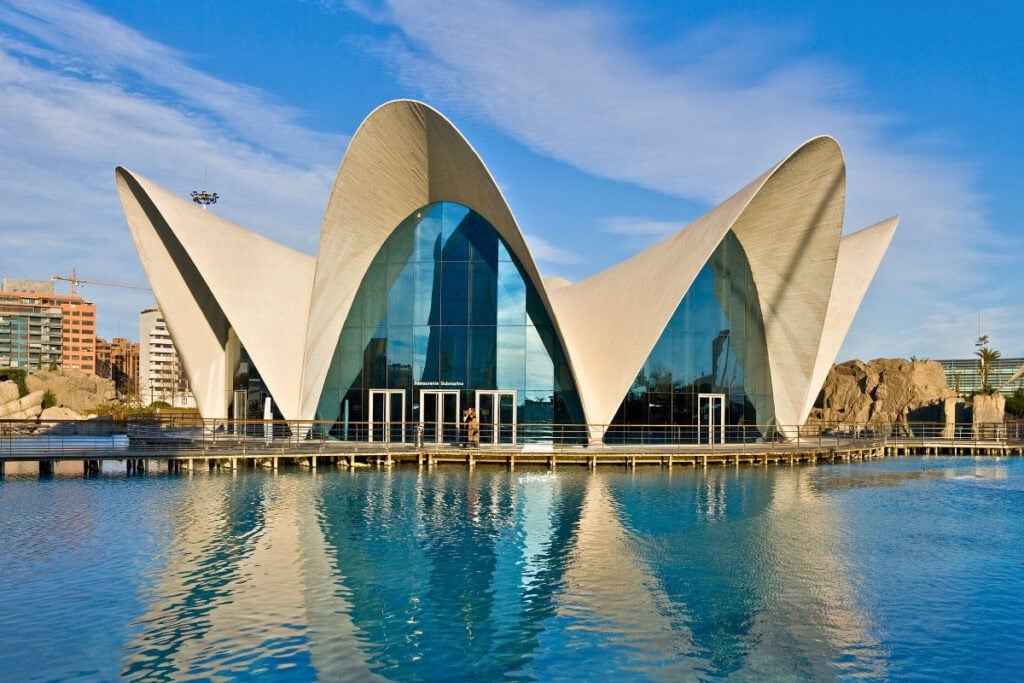
8. Príncipe Felipe Science Museum
The Príncipe Felipe Science Museum is located at the City of Arts and Sciences and makes an excellent attraction for all ages. If you’re travelling with children, this interactive museum will definitely keep them engaged and entertained.
The museum opened in 2000 and is instantly recognisable by its building which looks like the skeleton of a whale. Inside you’ll find a variety of hands-on exhibits covering science, technology and innovation – everything from space exploration to the human body.
The exhibitions are designed to be interactive and educational, spanning different scientific disciplines whilst keeping visitors engaged through fun, practical demonstrations. Alongside the permanent displays, there are temporary exhibitions and workshops that change throughout the year.
Book tickets in advance to avoid disappointment, especially during school holidays when the museum gets particularly busy. Allow 2-3 hours for your visit to explore all the different sections properly.
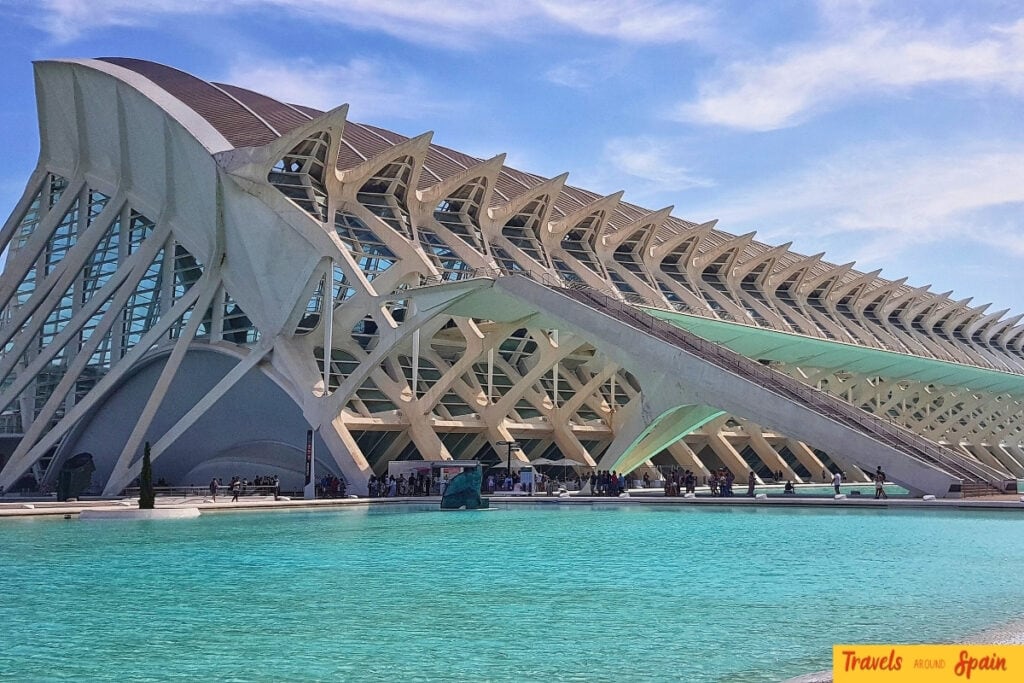
Valencia Food & Drink Experiences
9. Savour Authentic Paella – Valencia’s Most Famous Dish
Valencia is home to many delicious dishes, none more famous than paella. That’s right, the world-famous rice dish originated right here in Valencia and you can experience some of the most authentic paella in Spain!
The dish gets its name from the wide, shallow pan used to cook it. Originally a lunchtime meal for farmers, paella contained whatever ingredients they could gather seasonally. Combined with rice, saffron, meat or seafood, and cooked in olive oil with chicken broth, this hearty meal became Valencia’s signature dish.
You cannot leave Valencia without trying authentic paella – it’s genuinely one of the best things to do in Valencia for food lovers. Two of my favourite spots are Rincón 33, where we had a delicious seafood paella. My other recommendation is Restaurant Navarro, widely considered one of the best places for traditional paella with rabbit and green beans.
Both restaurants serve paella the proper Valencian way – cooked to order and meant for sharing. Expect to wait 20-30 minutes as authentic paella cannot be rushed!
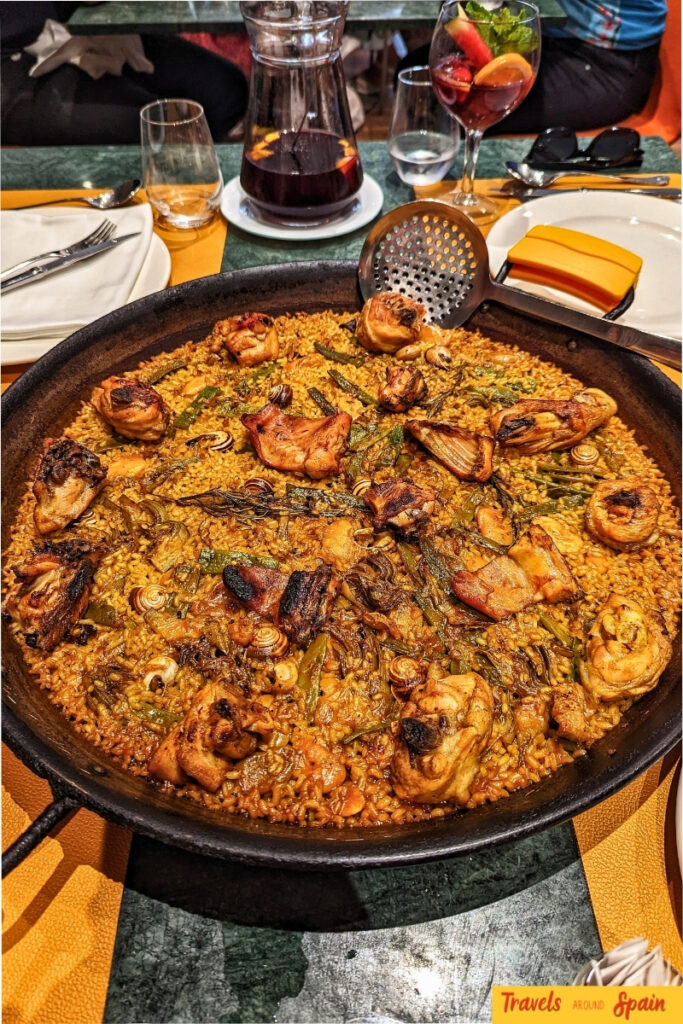
10. Try Agua de Valencia – The City’s Signature Cocktail
You may have heard of Mimosas or Buck’s Fizz, a famous cocktail combining sparkling wine with orange juice. Popular at brunches, this cocktail is refreshing, light and a nice addition to a boozy brunch. Well, get ready for Valencia’s own version!
Agua de Valencia (Water of Valencia) is Valencia’s most iconic cocktail and one of the best things to try in Valencia. It’s incredibly refreshing and although originally an evening drink, can now be enjoyed at any time of day. It was created in the 1950s at Café Madrid Valencia by bartender Constante Gil and is now emblematic of the city.
Similar to mimosas, Agua de Valencia combines Spanish sparkling wine (cava) with fresh orange juice. The difference comes with the addition of two extra spirits: vodka and gin. With these extra spirits, it’s more potent than a mimosa but even more delicious.
You’ll find Agua de Valencia on menus throughout the city, from traditional bars to modern cocktail lounges. It’s a definite must-try when visiting Valencia and perfect for toasting your Spanish holiday!
11. Eat Your Way Around Central Market – Valencia’s Food Paradise
As you can probably guess, Valencia has a strong connection with food. As the birthplace of paella and home to a rich array of regional dishes, the city takes enormous pride in its gastronomic heritage.
One of the best places to experience Valencia’s food culture is Central Market (Mercado Central/Mercat Central). Located in Valencia’s Old Town close to the Silk Exchange, this stunning market is an iconic symbol of the city and one of Europe’s largest fresh food markets.
The market dates back to the early 20th century and the Art Nouveau building itself is breathtaking. Entering the market you’re hit with an incredible array of smells, sights and sounds as locals and tourists browse the stalls. The market is still very much used by locals, making it an authentic place to experience traditional Spanish market culture.
You’ll find an amazing variety of stalls selling Spanish cheeses, cured meats, fresh fruits, vegetables, spices, and local specialities like horchata ingredients. There are also food stalls where you can sample local produce and grab a quick bite, making it perfect for a food tour of Valencia’s Old Town.
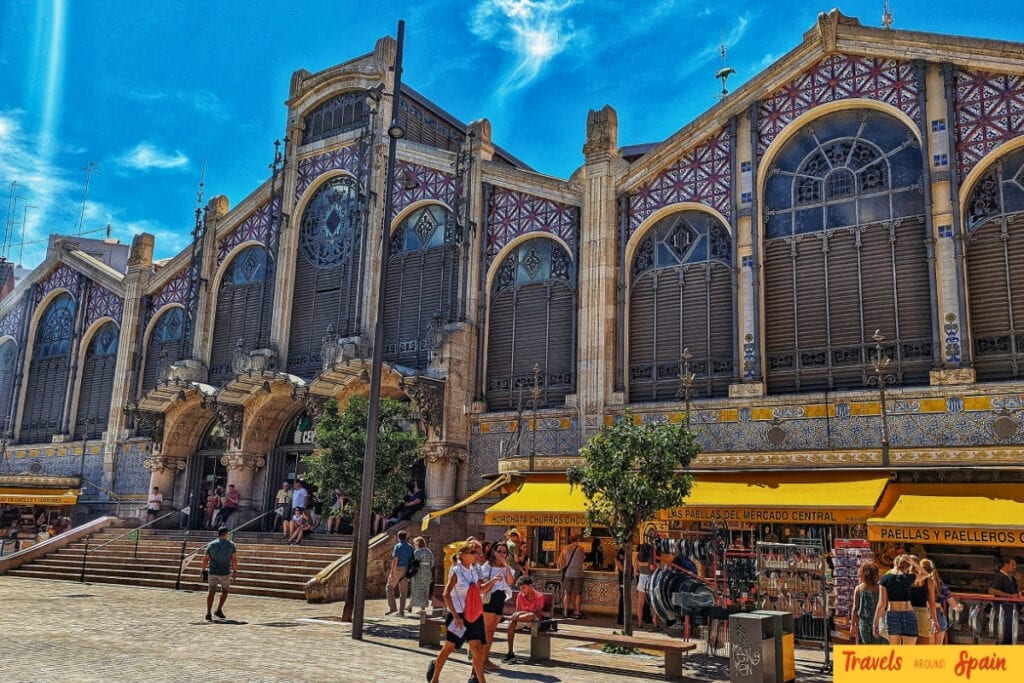
12. Cool Down with Delicious Horchata – Valencia’s Traditional Drink
You didn’t think I’d get to the end of this list without mentioning one of Valencia’s most famous drinks, did you? Horchata (known as orxata in Valencian) is a milky drink made of crushed tiger nuts, water and sugar. The result is a deliciously creamy, sweet and refreshing drink that has become synonymous with the city.
Horchata is popular throughout the year in Valencia but is especially beloved during the hot summer months. The drink is served ice-cold and traditionally accompanied by fartons – sweet, elongated pastries that you dip into the horchata like Spanish churros.
It’s definitely an acquired taste and received a mixed response from my family when we visited the city. I absolutely loved it but it wasn’t universally appreciated, so you’ll have to try it for yourself and decide!
For the best horchata in Valencia, head to Horchatería Santa Catalina, a historic café that’s been serving horchata since 1836 in charming traditional surroundings. It’s located centrally right by Valencia Cathedral and remains popular with both tourists and locals. It’s one of the most authentic Valencia experiences you can have.
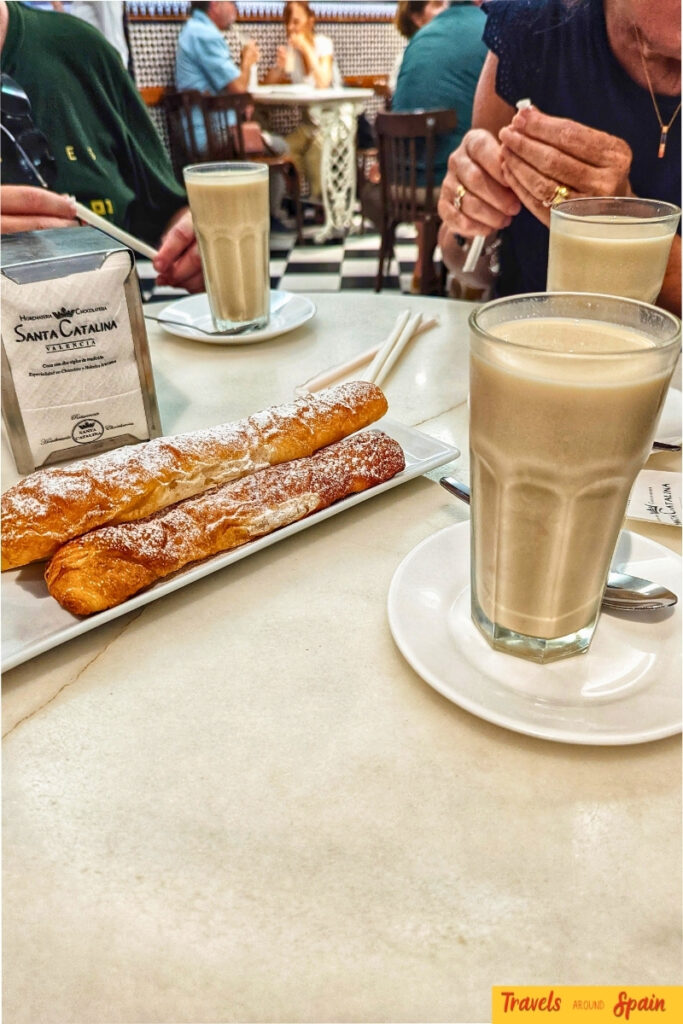
Valencia Beaches & Outdoor Activities
13. Relax at Malvarrosa Beach – Valencia’s Golden Sand Paradise
Valencia is the city with everything! It even has a beach! Perfect for relaxing after a day of sightseeing or spending a full day chilling out on a longer trip, Valencia’s beaches are beautiful, with golden sands and crystal-clear Mediterranean waters.
Malvarrosa Beach is Valencia’s most famous beach and located just 30 minutes by bus or tram from the city centre. It’s popular with tourists and locals alike who head down to the beach in the summer months after work with their families.
We spent a full day at Malvarrosa Beach in September during our trip. The weather was beautiful, the water temperature was perfect, and the beach wasn’t overcrowded. There are also plenty of beachfront restaurants and chiringuitos where you can grab fresh seafood paella or cold drinks when you get hungry.
The beach stretches for over 1km of fine golden sand and offers excellent facilities including showers, sun lounger rentals, and beach volleyball courts. It’s easily one of the best urban beaches in Spain and perfect for combining city sightseeing with beach relaxation.
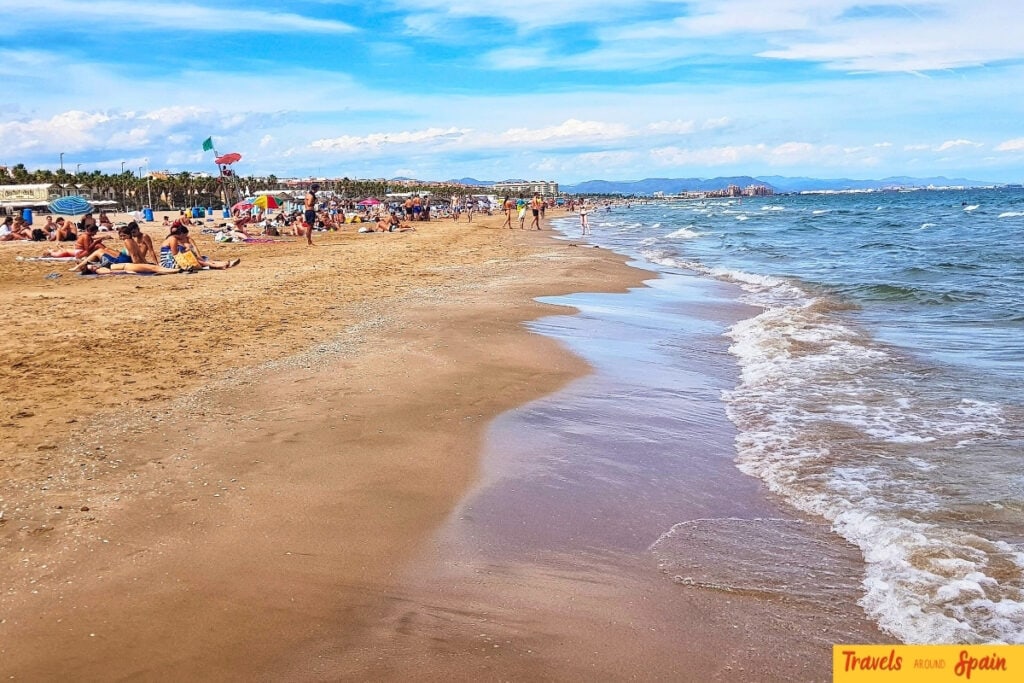
14. Walk Through Turia Gardens – Europe’s Largest Urban Park
Another example of Valencia’s constant innovation is the beautiful Turia Gardens. Snaking through the heart of the city, this 9-kilometre linear park provides an escape from the hustle and bustle right in Valencia’s centre and is one of the best free things to do in Valencia.
What makes the Turia Gardens so unique is their origin – the park was once the bed of the Turia River, hence its distinctive snaking design around the city. After devastating floods in 1957, the city diverted the river, leaving behind a huge area of land in the city centre.
Urban planners and landscapists were brought in to create one of Europe’s largest urban parks. The Turia Gardens are now a lush landscape of palm-lined promenades, manicured gardens, and architectural landmarks including sculptures, historic bridges and fountains dotted throughout the park.
The park is now an integral part of Valencian life – locals can be seen cycling, jogging, and relaxing in the peaceful surroundings. It’s also become a cultural hub hosting events, concerts, and festivals throughout the year, making it perfect for any visit to Valencia.
The gardens connect many of Valencia’s top attractions including the City of Arts and Sciences, making it an excellent way to walk between sights whilst enjoying green space in the city centre.
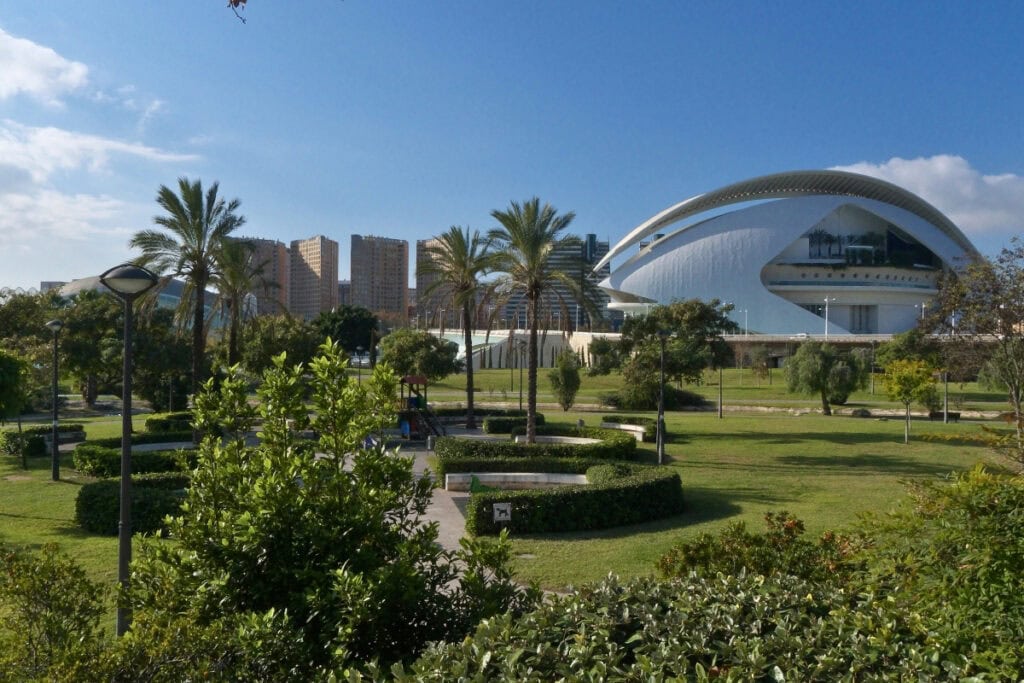
15. Get Back to Nature with Albufera Natural Park – Valencia’s Wetland Paradise
Whilst Valencia has plenty to do within the city, the wider Valencia region offers beautiful natural escapes and fantastic day trips for those staying longer or wanting to escape urban life.
Albufera Natural Park is one of the most popular day trips from Valencia and just 30 minutes south of the city. This freshwater lagoon is famous for its wetlands, sand dunes and marshes – plus it’s one of Spain’s most important bird-watching destinations with over 350 species recorded.
There’s plenty to experience at Albufera Natural Park. You can take traditional boat trips across the lagoon (especially popular at sunset), explore walking trails through the wetlands, or relax on the nearby beaches. The fishing village of El Palmar is particularly charming – famous for its traditional thatched-roof houses and authentic seafood restaurants.
This is actually where paella originated – El Palmar’s restaurants serve some of the most traditional paella recipes in the Valencia region, often cooked over wood fires in the traditional manner. Many visitors combine boat trips with authentic paella lunches for the complete Albufera experience.
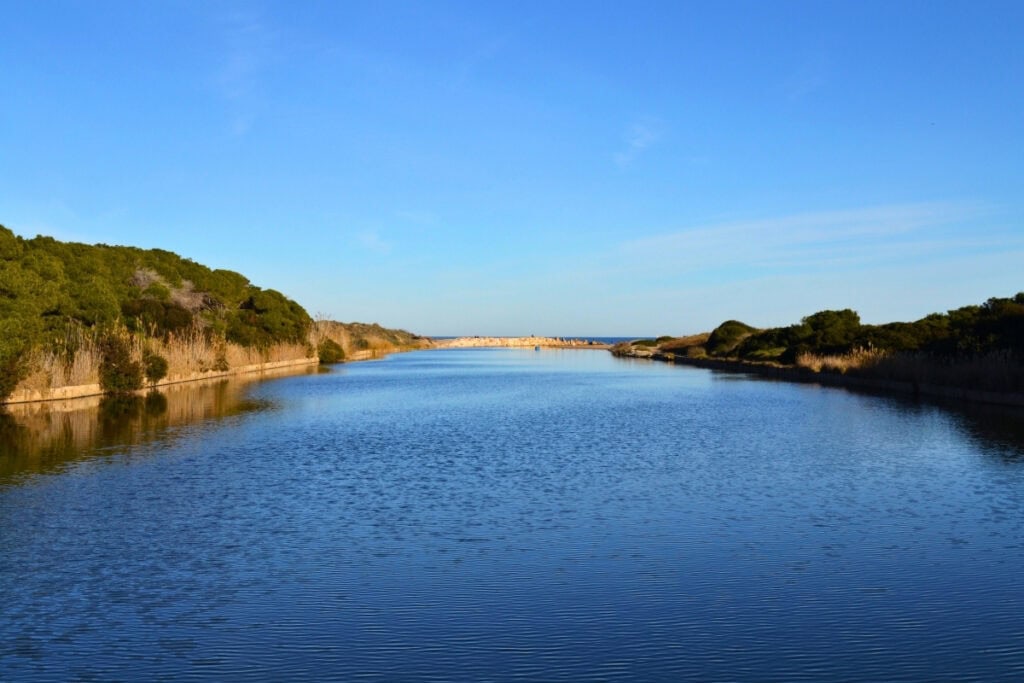
Frequently Asked Questions
What is Valencia Spain best known for?
Valencia is famous for authentic paella (the dish originated here), its stunning Old Town containing the Holy Grail in Valencia Cathedral, and over 300 days of sunshine annually. It’s also known for the futuristic City of Arts and Sciences and Las Fallas festival. Valencia remains Spain’s best-kept secret compared to overcrowded Madrid and Barcelona.
What are the best things to do in Valencia Spain?
The top Valencia attractions include the City of Arts and Sciences complex, Valencia Cathedral with the Holy Grail, authentic paella restaurants like Restaurant Navarro, Central Market food tours, Malvarrosa Beach, and exploring the historic Old Town. Don’t miss Turia Gardens for a peaceful walk and a horchata tasting at a traditional café.
What are the top 10 things to do in Valencia?
Valencia’s top 10 experiences: City of Arts and Sciences, Valencia Cathedral and Miguelete Tower, authentic paella lunch, Central Market tour, Malvarrosa Beach, Old Town walking, Turia Gardens, Oceanogràfic aquarium, UNESCO Silk Exchange, and Albufera Natural Park day trip. Each attraction offers something completely different.
How many days do you need in Valencia Spain?
3 days is perfect for first-time visitors to see Valencia’s main attractions, try authentic Spanish cuisine, and experience the city’s atmosphere. However, Valencia offers enough activities – from day trips to Albufera Natural Park to paella cooking classes – for a week-long holiday without boredom.
What are the best things to do in Valencia for first-time visitors?
First-time visitors should prioritise the City of Arts and Sciences, Valencia Cathedral tour, authentic paella restaurant experience, Central Market food tour, Old Town exploration, and Malvarrosa Beach. This combination showcases Valencia’s historic charm and modern innovations perfectly.
When is the best time to visit Valencia Spain?
March to May and September to November offer ideal weather with fewer crowds. March is special for Las Fallas festival, whilst April to June provides perfect beach weather for Malvarrosa Beach. Summer (July-August) is hottest but brilliant for beaches, though expect higher prices and crowds.
Final Thoughts: 29 Best Things to Do in Valencia
Valencia truly is one of Europe’s most underrated destinations – a perfect blend of historic charm and modern innovation that rivals Barcelona and Madrid without the overwhelming crowds.
From the futuristic City of Arts and Sciences to the medieval Valencia Cathedral housing the Holy Grail, from discovering vibrant street art in El Carmen to climbing the ancient Serranos Towers, and from relaxing on golden Malvarrosa Beach to savouring authentic paella where it was invented – Valencia delivers incredible diversity in one compact, sunny city.
With over 300 days of sunshine, world-class museums, pristine beaches just 30 minutes from the historic centre, and the best paella restaurants in Spain, Valencia offers something special for every type of traveller. Whether you’re interested in history, architecture, food, beaches, or nightlife, you could easily spend a month here discovering new experiences.
Ready to experience Spain’s best-kept secret? Valencia awaits with open arms, endless sunshine, and some of the most authentic Spanish culture you’ll find anywhere in the country.
About Me

My name is Liam and I’m the owner and author of ‘Travels Around Spain’. I have been obsessed with Spain ever since my first visit 35 years ago. I am on a mission to visit and discover every part of this beautiful country and share all my hints and tips with you all.
Read more about my journey by clicking here.



